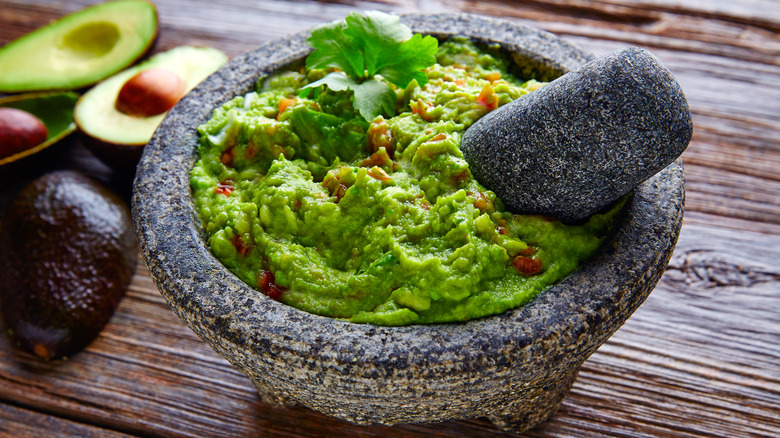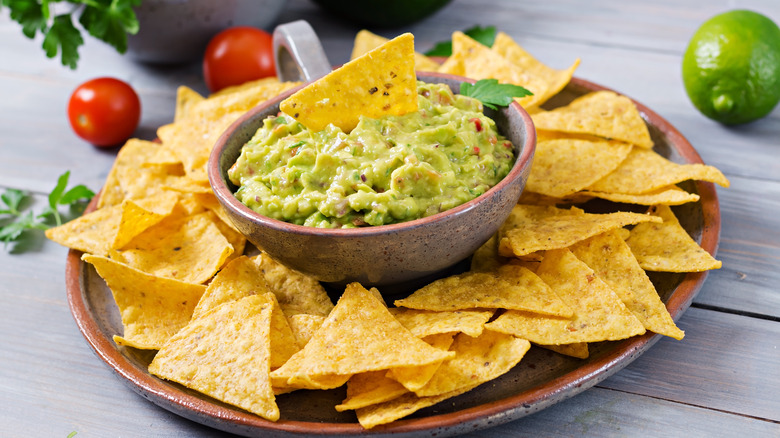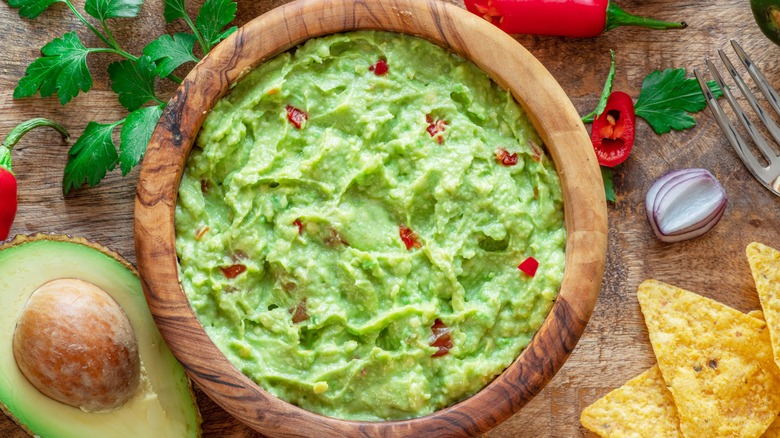The Origins Of Guacamole Are Much More Ancient Than We Thought
Guacamole has earned its legendary status — a perfect mix of salty and creamy, destined to elevate corn chips or top off any taco. It's the ultimate Super Bowl snack, trending in countless TikTok recipes, and just feels so undeniably of the moment. In fact, guacamole sales are projected to grow by over a billion dollars between 2024 and 2029 according to Market Data Forecast. For something that feels so buzzworthy and in the spotlight, it's hard to believe it dates back over 500 years. Turns out, guacamole's been a smashing hit since the Aztecs started the trend in the 1500s.
Back then, what we know today as guacamole was called ahuacamolli, a term derived from the Nahuatl words for avocado (ahuacatl) and sauce (molli). Avocados were incredibly popular in Mexico's Aztec Empire, not only because they were abundant in Central America's climate, but also due to their rich, velvety texture and high fat content — something rare and precious in their diet. The Aztecs even believed avocados had aphrodisiac qualities. However, don't expect their guacamole recipe to match the one at your favorite Mexican restaurant today. In honor of Hispanic Heritage Month (September 15-October 15), let's dig deeper into guacamole's ancient origins.
The original guacamole recipe was a little different
As with all great recipes, the guacamole we know today took time to reach its iconic form. The original recipe was simple, consisting primarily of avocados, which the Aztecs mashed into a creamy base using a mortar and pestle. There's some speculation that tomatoes, chiles, and sea salt might have been included, but historical records don't provide clear evidence. One thing is for sure: If Bobby Flay had been around back then, tomatoes would have been excluded from the recipe.
When the Spanish conquistadors arrived in what is now Mexico in 1519, they quickly became enamored with the Aztecs' ahuacamolli dish. Unable to pronounce the name, they adapted it to their own language, eventually leading to the word guacamole. As the Spanish introduced new ingredients to the Americas, the recipe evolved, with the addition of lime, garlic, onions, and cilantro transforming it into the dip we know today. Upon returning to Europe, they tried to replicate guacamole with other fruits, but nothing matched the smooth richness of avocados. (P.S. If you're craving silkier guacamole, we've got a grilling trick for you.) Frustrated, they also discovered that growing avocado trees outside of their native regions wasn't easy, making guacamole all the more special and elusive.
Guacamole wasn't initially popular in the U.S.
Guacamole may have been a staple in Mexico since the 1500s, but avocados didn't reach the United States until the early 1800s. Due to import bans, avocados were grown only in Florida and California and couldn't be imported from Mexico. Initially dubbed "alligator pear," the fruit's unappealing name didn't do it any favors, leading to a lack of interest. Americans were largely unaware of avocados' potential to become the dip that would later win countless hearts.
The turning point for guacamole came with a clever marketing campaign by the California Avocado Commission, which hired a PR firm to boost avocado popularity. The firm introduced the "Guacamole Bowl" during the 1992 Super Bowl, leveraging the event's massive viewership. NFL players and their families created unique guacamole recipes, and the public was invited to vote on their favorites. This publicity stunt catapulted guacamole into the American culinary spotlight. Today, 20% of all avocados sold in the U.S. are consumed on Super Bowl Sunday alone. (If your appetite's kicking in, here are the most Googled Super Bowl recipes for some ideas.)
The second major boost for guacamole came when trade restrictions on Mexican avocados were lifted in 1994. As these avocados became widely available, the growing Mexican-American community showcased guacamole at their restaurants. In tribute, National Guacamole Day was established in the early 2000s, coinciding with Mexican Independence Day and celebrating America's deep love for this historic and outrightly delicious dip.


